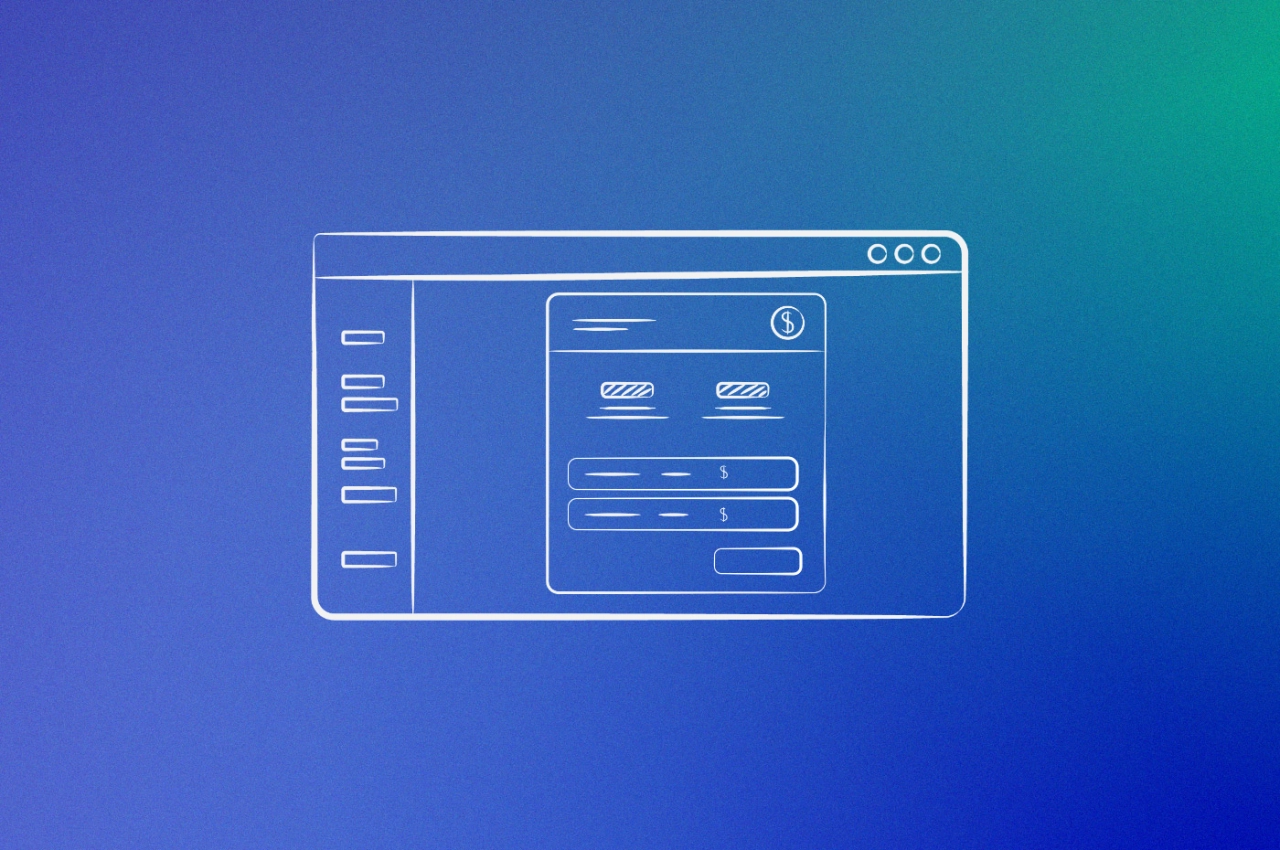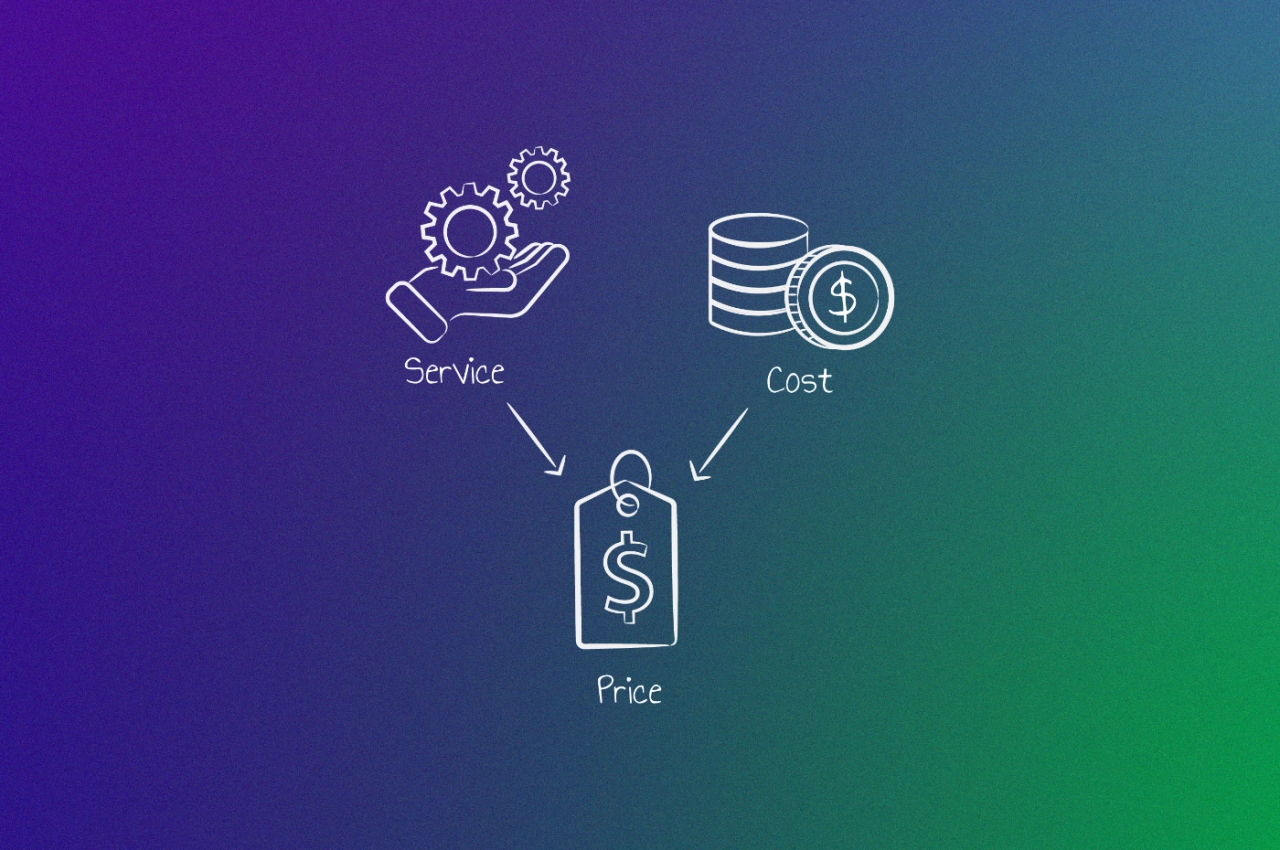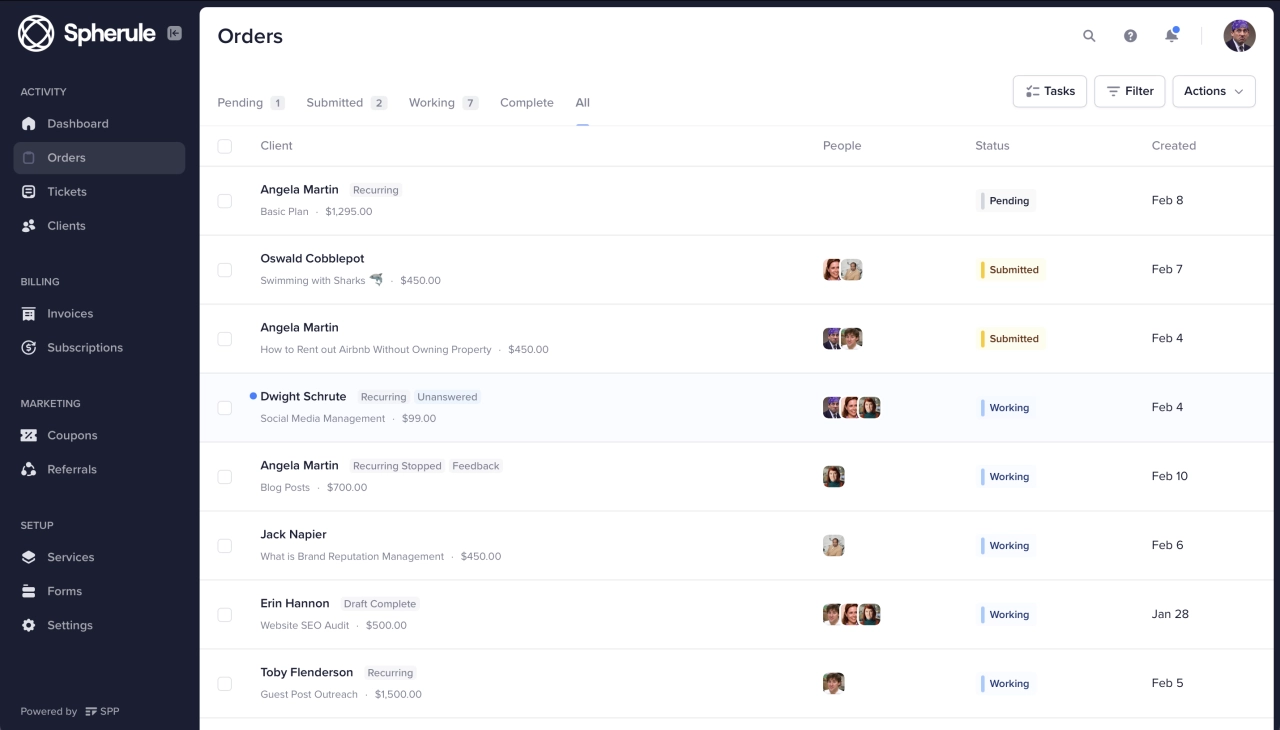- Retainer pricing transforms unpredictable project income into stable, reliable monthly revenue.
- Price retainers based on value delivered to clients, not just hours worked.
- Clear scope boundaries prevent retainers from becoming unprofitable all-you-can-eat service buffets.
Traditional agency pricing creates feast-or-famine cycles. One month your agency handles overwhelming project loads; the next month you scramble for new business. Unpredictable revenue keeps many agency owners awake at night.
Cash flow management represents a persistent operational challenge for digital agencies. According to Parakeeto, agency profitability experts who work exclusively with digital agencies, “maintaining a healthy cash flow tends to be a perpetual challenge“ due to fluctuations in payment timelines, project delays, and unexpected expenses¹. This challenge becomes particularly acute for agencies in the $1.5–5 million ARR growth phase, where financial forecasting difficulties often prevent agencies from scaling beyond that threshold². That’s precisely why retainer pricing models have become essential for agencies seeking predictable, sustainable growth.
Retainer pricing creates predictable revenue while delivering exceptional client value. This guide shows you how to implement it successfully.
What is retainer pricing?
Retainer pricing means clients pay a fixed, recurring monthly fee in advance. This provides ongoing access to your agency’s services throughout the agreement period. Unlike project-based pricing, where payment is tied to deliverables, retainer pricing creates a consistent revenue stream in exchange for ongoing value.
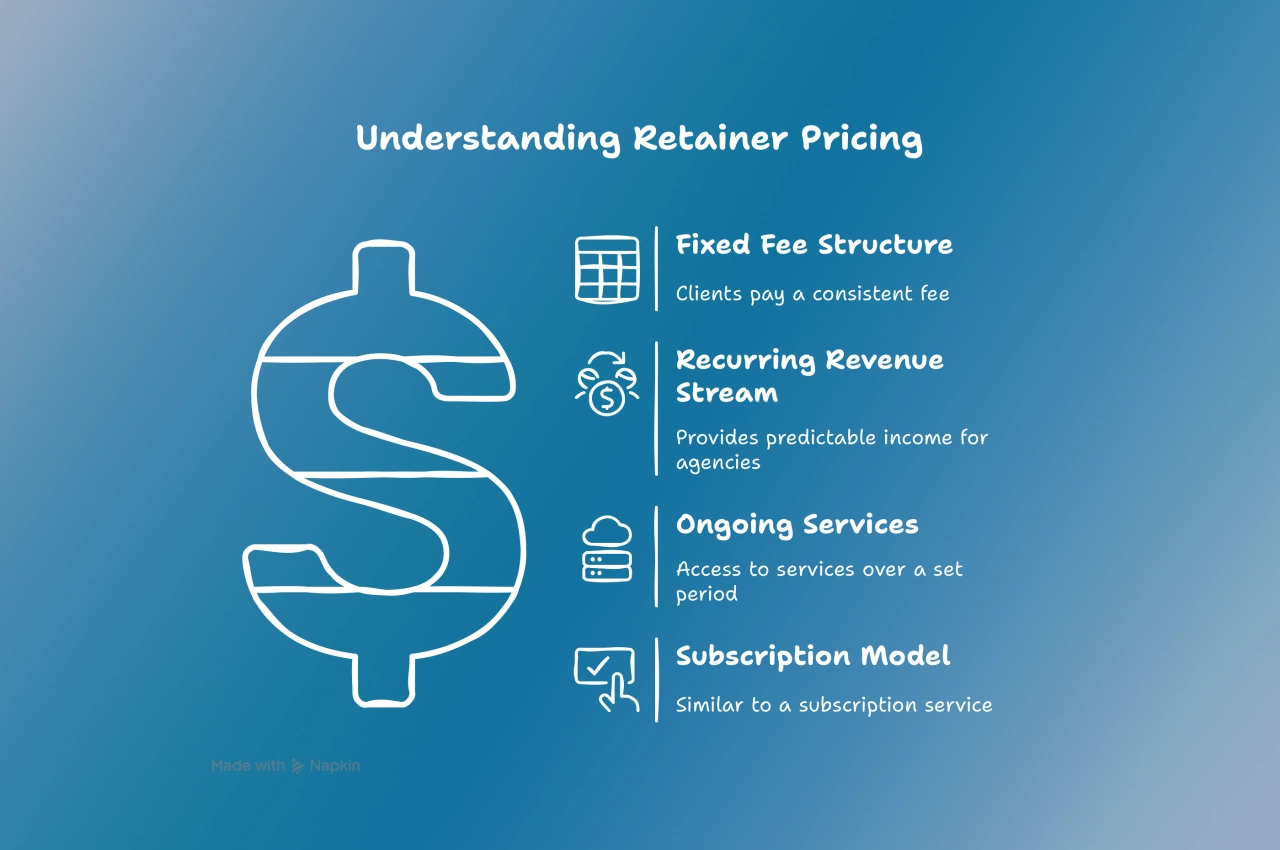
Clients subscribe to your agency's expertise rather than make one-time purchases.
Examples of marketing agency retainers
To make this concrete, here are several examples of how marketing agencies can structure their retainer offers:
SEO agency retainer: $3,500/month for comprehensive search optimization, including technical audits, content optimization, and monthly reporting
Social media management retainer: $2,000/month for daily posting across three platforms, community management, and performance analytics
Full-service digital marketing retainer: $7,500/month covering SEO, content creation, social media management, and PPC campaign management
CMO-as-a-service retainer: $10,000/month for strategic marketing direction, team leadership, and implementation oversight
Retainer pricing restructures your entire approach to client relationships. Focus on ongoing value rather than one-off deliverables.
SEO retainer services: pricing and structure
SEO agencies face a unique challenge: search optimization requires ongoing attention, but project-based pricing makes continuous optimization nearly impossible. SEO retainer services solve this by providing the sustained focus that actually moves rankings.
Unlike one-off SEO projects, retainers acknowledge that optimization is never done. Google’s algorithm updates don’t wait for your next project proposal, and competitors aren’t taking breaks between your client engagements.
What’s included in SEO retainer services
Most successful SEO agencies structure their retainers around four core service areas:
Technical maintenance: Monthly site audits, Core Web Vitals monitoring, and indexing issue resolution
Content optimization: Ongoing page improvements, keyword strategy updates, and content refreshing
Performance tracking: Ranking monitoring, traffic analysis, and strategic adjustments
Strategic consultation: Regular planning sessions and competitive analysis
SEO monthly retainer pricing benchmarks
Service Level | Monthly Range | What’s Included |
|---|---|---|
Local SEO | $1,500–$3,500 | Google Business Profile, local citations, near me optimization |
Small Business SEO | $2,500–$5,000 | Keyword strategy, content optimization, technical maintenance |
Mid-Market SEO | $4,000–$8,000 | Advanced strategy, competitor analysis, comprehensive optimization |
Enterprise SEO | $7,500–$15,000+ | Complex technical management, strategic consultation, team coordination |
Why SEO retainers outperform project work
When you’re embedded in a client’s business through a retainer, you understand their seasonal patterns, customer behavior, and competitive landscape. This deeper relationship translates into better results and fewer emergency situations that project-based relationships can’t address proactively.
From a business perspective, retainers eliminate the constant hunt for new projects. Your team develops deeper expertise instead of constantly context-switching, and you can focus on delivering exceptional results rather than pitching new work.
5 retainer pricing models for agencies
Let’s look at the most common retainer pricing models used by successful marketing agencies.
1. Hourly credits retainer
Clients pre-purchase a set number of hours each month in this model. They allocate these hours across different services, but unused hours don’t roll over.
How it works: The client pays upfront for 20 hours of agency time at $150/hour ($3,000 monthly retainer). They can allocate these hours across different services as needed.
Best for: Agencies offering diverse services where client needs vary month-to-month.
Tip: Always implement a "use it or lose it" policy where unused hours don’t roll over—this incentivizes clients to fully utilize their investment while protecting your revenue stability.
2. Output-based retainer
This model provides specific, predefined services for a fixed monthly fee.
How it works: A client pays $4,500/month for a content marketing package that includes 4 blog posts, 15 social media posts, and 1 email newsletter.
Best for: Specialized agencies with standardized delivery processes.
3. Results-based retainer
Here, pricing is tied to specific performance metrics or outcomes.
How it works: Base fee of $2,500/month plus performance bonuses when certain KPIs are exceeded (e.g., $500 for every 10% increase in conversion rate above baseline).
Best for: Established agencies with proven track records that can confidently predict results.
4. Tiered retainer packages
The tiered retainer model offers different service levels at corresponding price points.
How it works:
Bronze package: $1,500/month for basic SEO and content
Silver package: $3,000/month adds social media management
Gold package: $5,000/month includes paid advertising management
Best for: Agencies looking to create clear upsell paths and accommodate different client budget levels.
5. Value-based retainer
This advanced approach bases pricing on the estimated business value delivered, rather than time or deliverables.
How it works: If your SEO services typically generate $15,000 in additional monthly revenue for similar clients, you might charge a $5,000 monthly retainer (capturing ⅓ of the value created).
Best for: Sophisticated agencies with strong analytics capabilities and confidence in their impact on client business outcomes.
5 retainer pitfalls that kill agency profits
After seeing hundreds of agencies implement retainer models, I’ve observed these recurring issues:
The scope creep trap
What it looks like: “Could you just quickly add this small task?”
Why it’s dangerous: These quick tasks compound and destroy profit margins. They also set dangerous precedents for future free work.
Prevention strategy: Document every out-of-scope request and implement a formal change order process through your client portal.
The always available expectation
What it looks like: Clients sending urgent requests at all hours expecting immediate response.
Why it’s dangerous: Creates team burnout and impossible service standards.
Prevention strategy: Clearly define response time expectations in your retainer agreement and set up automated responses for after-hours communications.
The value communication failure
What it looks like: “We’re not sure what we’re getting for our monthly fee anymore.”
Why it’s dangerous: Leads to contract cancellation when budgets tighten.
Prevention strategy: Implement monthly executive summaries that translate your activities into business impact metrics.
The resource allocation imbalance
What it looks like: Some retainer clients consuming significantly more resources than allocated in your pricing model.
Why it’s dangerous: Creates hidden unprofitability that’s often discovered too late.
Prevention strategy: Track time against all retainer clients and review profitability monthly.
The retainer as discount perception
What it looks like: “Since we’re paying you monthly, we should get a significant discount on your services.”
Why it’s dangerous: Positions your retainer as a commodity rather than a premium service.
Prevention strategy: Frame retainers around priority access, strategic continuity, and proactive service—never around discounted rates.
How to calculate profitable retainer fees
The most common mistake agencies make with retainers is underpricing. Let’s walk through a practical process to calculate profitable retainer fees.
Determine your actual costs
Start by calculating your true hourly costs. For a small agency, this includes:
Direct labor costs: Salaries and benefits for delivery team
Overhead expenses: Office, software, utilities, and equipment
Administrative time: Client communication and project coordination
Management oversight: Strategic planning and quality assurance
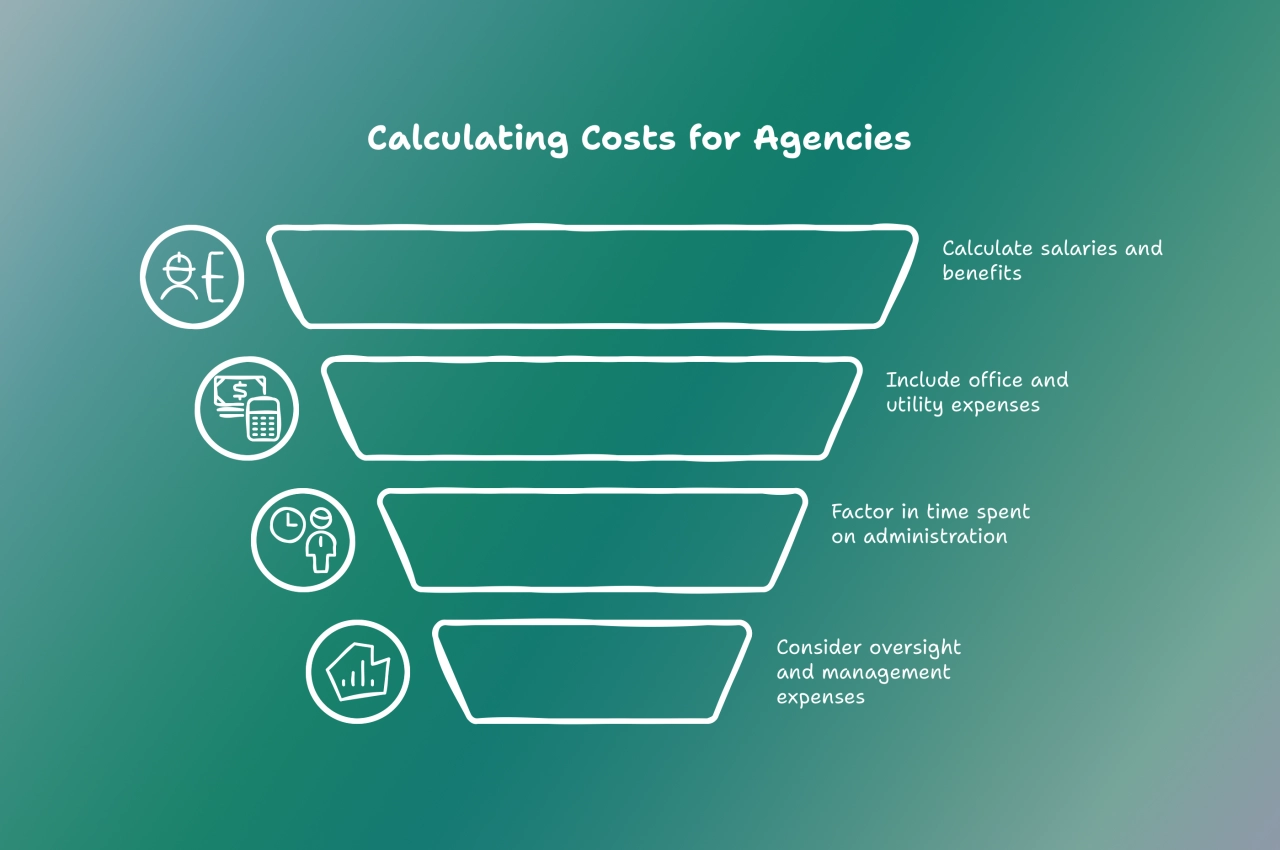
Example: If your total monthly costs are $30,000 and your team has 640 billable hours available (4 people × 160 hours), your minimum cost per hour is $46.88.
Add your target profit margin
For sustainable agency growth, implement a tiered margin approach: target 60-70% delivery margins on direct costs and 25-35% net profit margins overall. According to Promethean Research’s industry analysis, successful agencies average 15% net margins, while agency profitability specialists at Parakeeto recommend targeting 25–35% net margins with 60–70% delivery margins. This framework ensures both operational efficiency and long-term financial sustainability.
Example: For a 65% delivery margin on a $46.88 hourly cost, charge $134 per hour ($46.88 ÷ 0.35 = $133.94). This ensures sufficient gross profit to cover overhead expenses and achieve the 25–35% net profit margins recommended for sustainable growth.
Estimate service delivery requirements
For each retainer service, map out the typical hours required:
Content creation: 12 hours/month
SEO optimization: 10 hours/month
Client meetings: 4 hours/month
Reporting: 2 hours/month
Account management: 2 hours/month
Total: 30 hours/month
Calculate your minimum viable retainer
Multiply required hours by your target hourly rate: 30 × $134 = $4,020. Don’t limit yourself to hourly pricing alone. Your service value likely exceeds your time investment.
Add value-based premium
Fret not about charging solely based on hours—the true value of your services likely exceeds your time investment.
Consider adding a premium based on:
your specialized expertise
market positioning
client’s potential ROI
competitive landscape
For our example, adding a 30% value premium brings our monthly retainer to $2,742.48, which we’d likely round to $2,750.
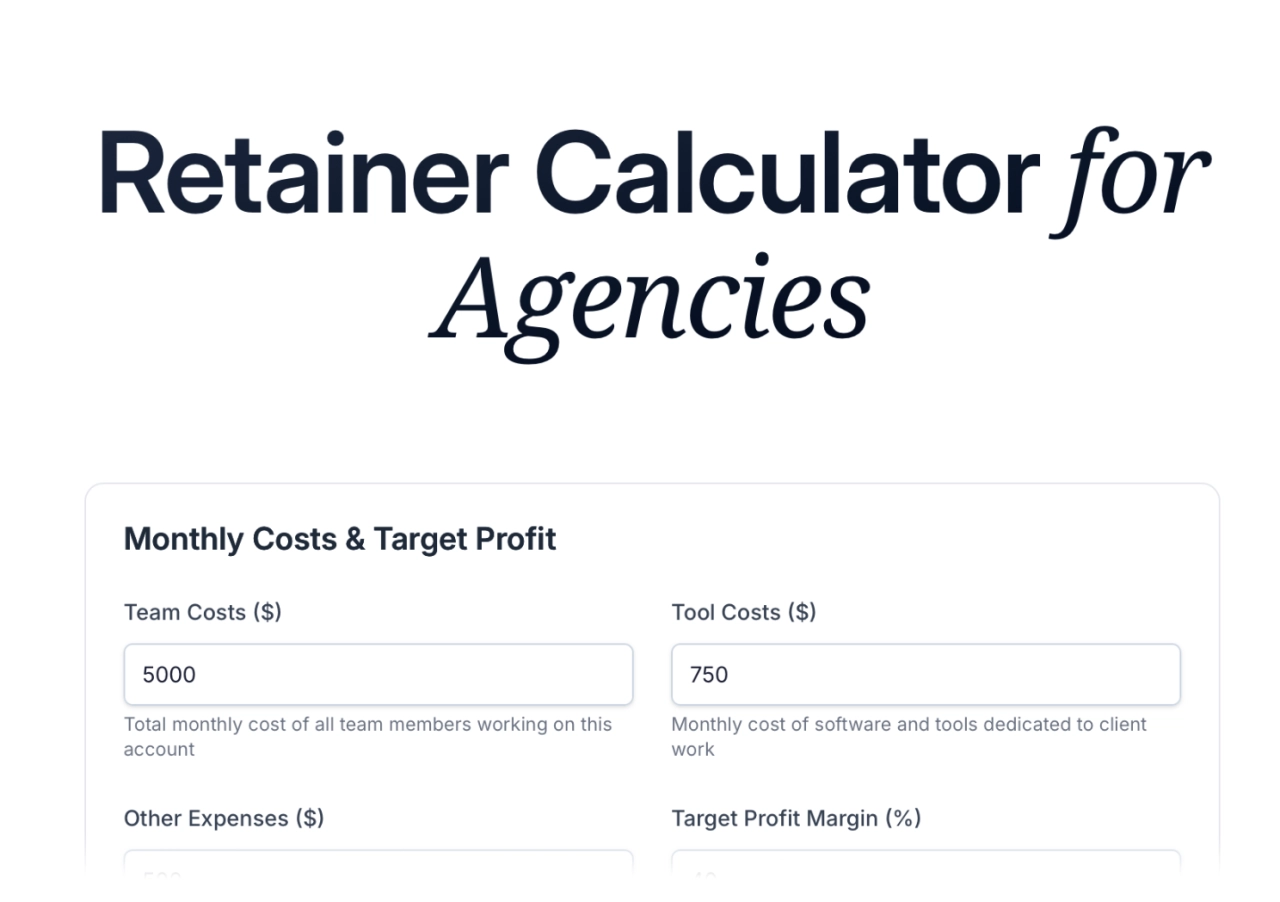
Use cost-plus pricing to calculate your retainer
Industry retainer pricing benchmarks
Understanding actual market rates helps you price competitively while maintaining healthy margins. Recent industry surveys reveal significant variation in what agencies charge:
Provider Type | Monthly Retainer Range | Survey Source |
|---|---|---|
SEO Freelancers | $251-$1,000/month | Ahrefs survey (350 professionals)⁵ |
SEO Agencies | $500-$2,000/month | SE Ranking survey (260 agencies)³ |
SEO Consultants | $1,000-$5,000/month | Ahrefs survey (350 professionals)⁵ |
Note: Data above reflects documented surveys. Other service pricing varies widely and lacks comprehensive survey data.
Key findings
According to SE Ranking’s 2025 survey of 260 agencies:
64% of SEO agencies charge below $1,000/month for retainers
30% charge less than $500/month (primarily smaller agencies and freelancers)
Only 13% charge $2,000-$5,000/month (established agencies)
Just 2% charge more than $5,000/month (premium/enterprise agencies)
Ahrefs’ survey of 350 SEO professionals found:
$501–$1,000/month is the most popular retainer range (20.4% of respondents)
Agency average: $3,209/month
Consultant average: $3,250/month
Freelancer average: $1,348/month

How to implement retainer agreements
Let’s look at how to successfully implement retainer pricing in your agency.
1. Define clear scope boundaries
The key to profitable retainers is precise scope definition:
specify exactly what’s included (and what isn’t)
set clear limits (e.g., "up to 4 rounds of revisions")
outline additional fees for work beyond scope
document communication expectations (response times, available hours)
Managing expectations outside of scope - although we have retainer-based services we have often had clients request elements (i.e. client comms and reporting) as an extra that’s outside of scope, not included within the monthly hours. This has led to use being quite specific with our scopes of work to ensure that everything is fully accounted for including looking at detailed onboarding information and using value reviews to show clients what has been paid for vs what has been delivered. This is especially valuable for clients who spend a lot of time on communication and don’t realise it’s eating into their delivery budget.
 Amanda Walls,
Cedarwood Digital
Amanda Walls,
Cedarwood Digital
2. Create a structured onboarding process
Successful retainers begin with thorough onboarding:
welcome packet with process overview
kickoff meeting to align on goals and expectations
collection of all required client materials and access
setting baseline metrics for performance tracking
introduction to your client management system
Tip: Use a client portal like SPP.co to streamline this process and set professional expectations from day one.
3. Establish value-demonstration protocols
Regular reporting is essential for retainer success:
weekly progress updates (brief email or portal update)
monthly comprehensive performance reports
quarterly strategy reviews to realign priorities
annual relationship reviews to discuss renewal terms
4. Implement change management procedures
Create a formal process for handling scope changes:
change request form in your client portal
impact assessment (how the change affects timeline/resources)
additional fee calculation when applicable
approval workflow before implementing changes
5. Build renewal and upsell strategies
Don’t leave renewals to chance:
proactive renewal discussions (60-90 days before contract end)
performance-based upsell opportunities
loyalty incentives for long-term commitments
exit interviews for non-renewing clients to improve offerings
Setting up retainer management in SPP.co
Let’s look at the specific steps to implement your retainer model in SPP.co.
Create a retainer service
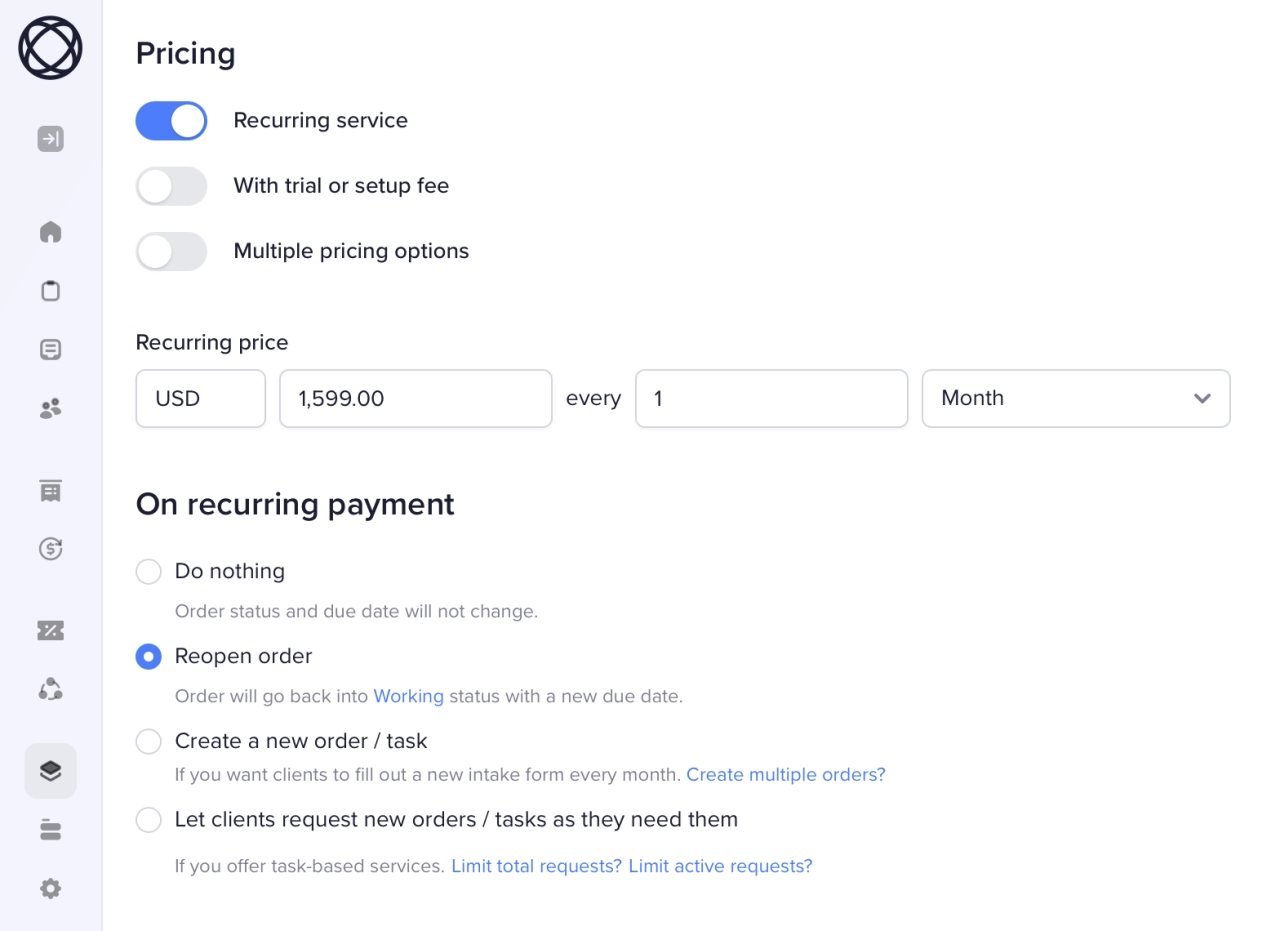
Navigate to Services → + Service and toggle “Recurring service” on. Set the billing cycle to monthly and define clear deliverables in the service description.
Optimize the client dashboard
By default, the client dashboard shows the order view. If your clients don’t have more than one order, it makes sense to replace the default dashboard with the onboarding page that you can customize.
Give the client tasks to fullfill (such as uploading brand information), add an introduction video, and give them an idea of the next steps to expect.
Automate your reporting
SPP.co supports different reporting integrations that you can use natively, from Agency Analytics to Whatagraph. Set up reports for your clients and allow them to access them easily in the sidebar.
Configure client communication
Set up automated check-in messages at day 15 of each cycle. While SPP.co doesn't support internal automations, you can use the Zapier integration to set this type of automation up.
This systematized approach creates a professional experience while reducing the administrative overhead that often eats into retainer profitability.
Overcoming common client objections to retainer pricing
Even with a well-structured retainer model, you’ll face objections. Here’s how to address the most common ones.
It’s too expensive compared to project-based pricing
Response: I understand your concern about the investment. What makes our retainer model valuable is the continuous optimization and strategic oversight you receive. With project work, you’re paying for isolated deliverables—with our retainer, you’re investing in ongoing results and improvements that compound over time. Most clients see significantly better ROI by month three compared to one-off projects.
We don’t need all those services every month
Response: That’s actually why our retainer model is flexible by design. While the specific tactics may shift based on your needs each month, our team’s focus remains constant: driving [key metric] for your business. Some months we might emphasize content creation, while others we’ll focus more on conversion optimization—always prioritizing the highest-impact activities for your current situation.
We prefer to pay for results, not ongoing services
Response: I appreciate that perspective! That’s why we’ve structured our reporting to clearly demonstrate ROI. Additionally, we can explore our performance-based retainer option where part of our compensation is tied directly to achieving specific metrics we agree upon. This aligns our incentives even more closely with your business goals.
We’re not ready for a long-term commitment
Response: I completely understand wanting to ensure we’re the right fit before making a longer commitment. We offer a 3-month initial retainer that allows you to experience our process and see preliminary results before deciding on a longer-term engagement. Most of our successful client relationships began this way.
Systems and tools for managing retainer-based services
Efficient operations are critical for maintaining retainer profitability. Here are the essential systems you need.
Client management platform
Implement a comprehensive client portal system like SPP.co that handles:
centralized communication
document sharing via file uploads
service delivery tracking
automated billing and invoicing
client dashboard with performance metrics
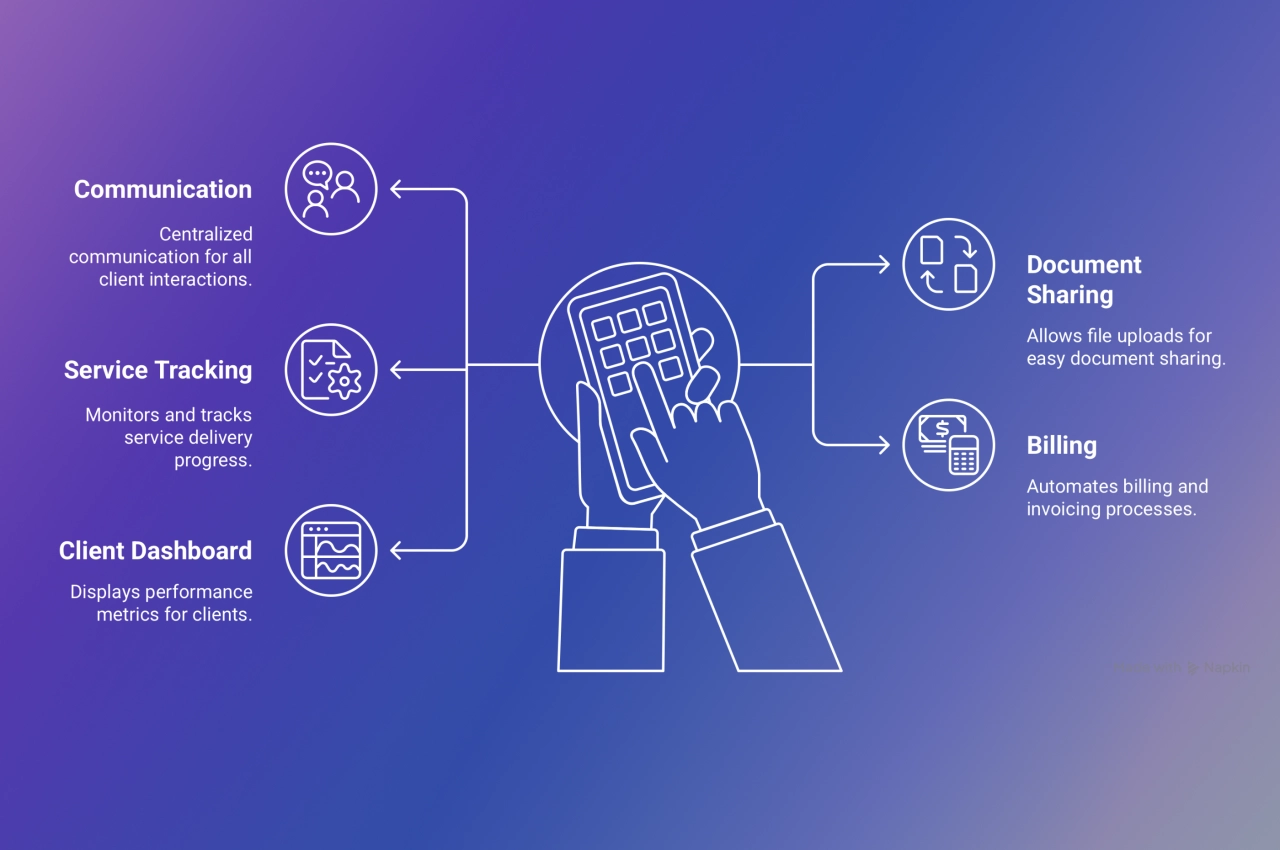
Time tracking and resource allocation
Implement detailed time tracking to ensure retainer profitability:
track time against retainer budgets
set up alerts when approaching hourly limits
analyze profitability by client and service type
forecast resource needs based on historical data
We utilise time tracking software to ensure that the team doesn't go over hours & then report these hours back each month to ensure that resource is being managed adequately. As a result, we are able to pinpoint when a client is being overserviced and address this quickly to prevent this becoming a trend for the client which can be an issue if it becomes an expectation further down the line."
 Amanda Walls,
Cedarwood Digital
Amanda Walls,
Cedarwood Digital
Automated reporting systems
Create efficient reporting processes:
templated performance reports with auto-populated data
client-facing dashboards with real-time metrics
scheduled report generation and delivery
annotated insights to contextualize raw data
Our client reports are nearly fully automated once we leveraged Looker Studio and Supermetrics in combination that allows us to pull data from just about every technology source.
 Maxwell DesMarais,
Vital Design
Maxwell DesMarais,
Vital Design
Frequently asked questions
What is a marketing retainer?
A marketing retainer is a monthly fee paid in advance for ongoing marketing services. Unlike project work, retainers provide continuous support across SEO, content marketing, social media, and advertising with dedicated teams and regular optimization.
What is a retainer fee?
A retainer fee is a monthly payment (typically $1,500-$15,000+) that secures ongoing access to professional services. It provides predictable costs, priority agency access, and continuous optimization rather than one-time project delivery.
How much do SEO retainer services cost?
SEO retainer services cost $1,500-$15,000+ monthly depending on business size and complexity. Small businesses typically pay $2,500-$4,000 monthly, while enterprise clients invest $7,500-$15,000+ for comprehensive management.
How long should my retainer agreements be?
Most successful marketing agencies start with 3-6 month initial terms, then transition to 12-month agreements for renewal. The longer commitment allows for more strategic planning and typically yields better results for clients.
Should I require a deposit or setup fee alongside the retainer?
Yes, a one-time setup fee of 50-100% of the monthly retainer amount is standard practice. This covers the intensive onboarding process and demonstrates client commitment.
How do I handle scope creep in retainer relationships?
Document everything meticulously and implement a formal change request process. When clients ask for work beyond scope, respond with: "I’d be happy to help with that. Since it falls outside our current agreement, I’ll prepare a quick estimate for the additional investment required.”
Closing thoughts
Implementing retainer pricing in your marketing agency isn’t just about creating predictable revenue—it’s about transforming your entire business model to focus on long-term client success rather than one-off deliverables.
I’ve hopefully given you a comprehensive framework for developing, pricing, and implementing retainer services that benefit both your agency and your clients. Remember that the transition doesn’t happen overnight—start with your most loyal clients, refine your processes, and gradually shift your new business development toward retainer-first offerings.
With the right approach, retainer pricing allows you to escape the feast-or-famine cycle, make confident hiring decisions, and focus on strategic growth rather than constant sales hustle.
Ready to implement retainer pricing in your marketing agency? Our team at SPP.co has helped hundreds of agencies make this transition successfully. [Book a demo today] to see how our client portal platform can streamline your retainer service delivery and help you scale with confidence.
---
Sources:
¹ Parakeeto. 9 Financial Challenges Digital Agencies Face and How To Overcome Them. March 4, 2024. https://parakeeto.com/blog/9-financial-challenges-digital-agencies-face-and-how-to-overcome-them/
² Petitpas, Marcel. A Quick Guide to Digital Agency Forecasting Parakeeto Blog, September 6, 2023. https://parakeeto.com/blog/a-quick-guide-to-digital-agency-forecasting/






